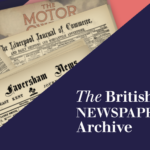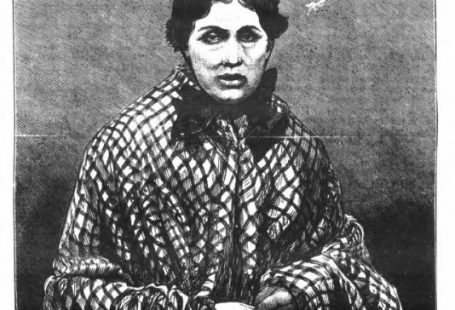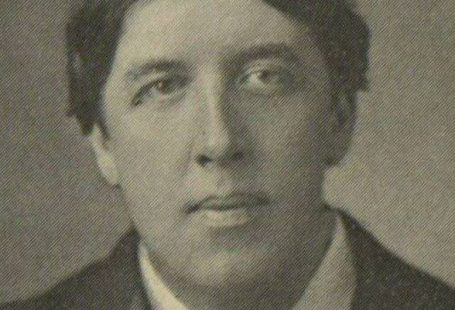This week at The Archive we are delighted to welcome 49,366 brand new pages to our collection, as we introduce five brand new newspaper titles. Our new titles this week feature some specialist publications, which represent the worlds of insurance and engineering, as well as the moral concerns of the early twentieth century. Meanwhile, we have introduced one brand new title from London, whilst we have made additions to three of our existing titles, from Scotland and England.
So read on to discover more about our intriguing new titles of the week, and to find out which of our existing titles we have updated. Also, you can find out more this week about the activities of the National Vigilance Association, an organisation that was set up in 1885 for the ‘repression of criminal vice and public immorality.’
Register now and explore the Archive
But before we take a look at criminal vice and public immorality, let’s take a look at our new London newspaper, which is the Forest Hill & Sydenham Examiner. First published on 9 August 1895 at the cost of one penny in Forest Hill and Sydenham, residential areas of south east London, this newspaper aimed to ‘benefit the district throughout which we circulate.’ The Forest Hill & Sydenham Examiner, therefore, aimed to report ‘fully’ on ‘matters of interest to the locality,’ meaning to make the publication ‘The Local Paper.’

Consequently, the Forest Hill & Sydenham Examiner did not ally itself to any of the day’s political parties, and concentrated on detailing all the local news from the area. For example, the newspaper, which cost just one halfpenny and was published every Friday, reported on items like the charitable fetes that were being held in Forest Hill and Sydenham, and discussed whether the locality should have a cottage hospital. Meanwhile, the Forest Hill & Sydenham Advertiser did look further afield to report on international and national news, as well as taking a look at sporting matters, especially cricket, whilst it also published serialised fiction.
Our next new title of the week is the Vigilance Record, which was ‘The Organ of the National Vigilance Association.’ The National Vigilance Association was founded in August 1885 ‘for the enforcement and improvement of the laws for the repression of criminal vice and public immorality,’ in response to an investigation by journalist W.T. Stead into child prostitution in Britain.

Stead’s articles were published in the Pall Mall Gazette, and launched the National Vigilance Association into life, the organisation growing rapidly from its inception. Early members of the group included suffragist Millicent Fawcett and social reformer Josephine Butler, and in 1885 the Miners’ Protection Society and the Society for the Suppression of Vice merged with the nascent group. Meanwhile, in 1899 the National Vigilance Association founded the International Bureau for the Suppression of Traffic of Persons, the group having a particular focus on the prevention of the white slave trade.
By 1917, the National Vigilance Association had grown to protect women, minors (including young men), and young children. It also had a focus on suppressing ‘obscene’ publications and improving public behaviour. Indeed, the organisation had something of a ‘busybody’ reputation, as we shall discover later on.

But by the 1920s and 1930s the National Vigilance Association was troubled by financial difficulties, despite having international influence and merging with the Travellers’ Aid Society in 1939. These financial troubles continued after the Second World War, and in 1952 the organisation merged with the British National Committee to become in 1953 the British Vigilance Association.
As for its ‘organ,’ the Vigilance Record, it was edited by William Alexander Coote (1842-1919), a moral reformer who co-authored A Romance of Philanthropy. This book represented a ‘remarkable record of the chief cases connected with the thirty years’ work of the National Vigilance Association.’ Meanwhile the Vigilance Record itself cost one penny and appeared on the first of the month, chronicling the work of the National Vigilance Association.

The Vigilance Record looked at the organisation’s efforts abroad, for example in Buenos Aires. It looked at ‘Our Office Work Day By Day,’ as well as the National Vigilance Association’s work at railway stations and cities across Britain. The publication was also concerned with ‘Morality and the Stage,’ as well as the morals of the film industry, containing, for example, an article entitled ‘Women Censors of Cinematograph Films.’ Responding to the increased moral panic precipitated by the First World War, the Vigilance Record highlighted the increasing immorality of Berlin, as well as British women’s involvement with soldiers.
Overall, the Vigilance Record represents a fascinating record, on the one side, attempting to help women who had found themselves in very vulnerable situations, whilst on the other, attempting to moderate and marshal the morals of a society in flux. Find out more about the National Vigilance Association and its work in the second half of this blog.
Heading up the trio of our new special industry and occupation titles this week is the Managing Engineer, the ‘Official Organ of the London Association of Foreman Engineers.’ First published in 1914 by Thomas Tofts in London, this publication appeared on the first of every month at the cost of one pence. It did not only represent the London Association of Foreman Engineers, the Managing Engineer was also the mouthpiece of the the Leeds Association of Engineers, the Birmingham Association of Mechanical Engineers, the Nottingham Society of Engineers, the Stoke on Trent Engineers’ Association, as well as containing news from other engineering societies across the United Kingdom.

The London Association of Foreman Engineers was founded in 1852. The aim of the organisation was to provide mutual help for members to find work, its founding statement explaining how:
The want of co-operation among Foremen of the Engineering Trade had long and deeply been deplored. There had existed between them no public and recognized channel of communication, and as a body they were unable to consult for their general interest, intellectual advancement, or individual advantage. Personally strangers, in most instances, they did not possess the power of recommending each other for vacant situations, nor was there any such thing as a fund from which those who happened to be unemployed could claim pecuniary aid.
Therefore, the London Association of Foreman Engineers aimed to end this isolation, and to help its members find work. By 1857 the group had 22 members, and in 1866 engineer Joseph Newton (c.1820-1892) became its president and chair. By 1868 the London Association of Foreman Engineers had grown to provide a widows’ and orphans’ fund. Monthly meetings were organised, and a library was established. The organisation eventually became known as the London Association of Foremen Engineers and Draughtsmen.

So what did its newspaper the Managing Engineer contain? Well, it contained the news from all the societies it represented, as well as from other societies like the Newcastle and District Foreman Engineers and Draughtsmen Association and Keighley Association of Engineers. It featured photographs of important members of the engineering profession, as well as detailed articles on the latest inventions, like mechanical limbs, which were also accompanied by photographs.
The Managing Engineer, meanwhile, reported on technical talks like ‘Metal Melting By Means of High-Pressure Gas,’ which was given to the Birmingham Association of Mechanical Engineers, and the ‘Manufacture of Pig Iron,’ which was given to the Leeds Association of Engineers. These reports included thorough diagrams and photographs, whilst the publication also contained adverts for all the tools of the engineering trade.

Our penultimate new title of the week is the Insurance Opinion, which was founded in 1891 and incorporated the Insurance Newspaper. Edited and owned by Charles H. Gregory, the Insurance Opinion appeared on the first of the month and filled sixteen pages, costing six pence. Indeed, the newspaper described itself as a ‘Monthly Journal that is steadily winning its way in the respect and confidence of Insurance Companies, and the Insuring Public,’ being a ‘Journal of Ideas and Intrinsic worth – Indispensable to Insurance Men.’
Indeed, the Insurance Opinion was packed full of articles, which looked at ‘Insurance Shares as Investments,’ and much more besides. We have published the year 1919 on The Archive, and this particular date range shines an illuminating light on life following the First World War in the United Kingdom. The newspaper, true to its purpose, noted:
Now that the glory of peace has come, we may hope that prosperity may come, and with peace and prosperity there should come not extravagance, but thrift, and the true thrift every self-respecting member of the community should desire is that form of security and investment which Insurance can provide.

Meanwhile, the Insurance Opinion looked at other post war issues, such as the provision of an estimated 1.5 million houses, and the amount of life insurance claims, which was exacerbated by the Spanish flu pandemic. It also answered questions like this one from a soldier’s wife, who enquired:
…if an Insured person is officially reported killed, and it is subsequently established that the report is incorrect, would the Insurance Company be entitled to a refund?
The answer in this instance was yes, and in this vein, the Insurance Opinion was nothing but thorough, providing detailed answers to such ‘enquiries.’ Meanwhile, the publication printed a section entitled ‘What We Hear,’ which reflected the ‘voice of enquirers, and public opinion,’ whilst also providing ‘Hints to Insurance Men,’ like this one below:
The way to encourage investment in life assurance, and indeed, in any other form of cover, is to protect the policyholder. See that the proposer gets a policy in the form best suited to his requirements.

The key, moreover, to the selling of insurance, at least according to this title, was enthusiasm. Meanwhile, the Insurance Opinion looked at ‘Insurance in Other Lands,’ as well as the news from British insurance companies. It also looked at new developments in the insurance world, such as the insuring of aircraft, which represented a ‘problem for insurance companies.’
Our final new newspaper title of the week is another insurance one, and it is the City Life Record. This was the official organ of the City Life Assurance Company, Ltd., and United General Commercial Insurance Corporation, Ltd., the former company describing itself as a ‘popular and progressive company,’ and indeed, the ‘most progressive in the Kingdom.’ Meanwhile, the United General Commercial Insurance Corporation stated that ‘it prided [itself] upon being the most progressive of all non-tariff companies.’
The City Life Record has its roots in a title called British Homes, which was published from 1896 onwards. In 1909 the publication changed its name to City Life Record, appearing monthly at the cost of two pence, and filling twelve pages. In 1920 the journal again changed its name to become Modern Insurance.

City Life Record contained a lengthy editorial piece, as well as portraits and profiles of the companies’ directors. Meanwhile, it took a detailed look at the history of insurance, as well as featuring a ‘Post Bag,’ which featured letters to the editor. Indeed, true to both companies’ claims to representing progression in the insurance world, the City Life Record does possess, perhaps, a more modern feel than its rival, Insurance Opinion.
That’s it from our new titles of the week, but we have also made updates to three of our existing titles. We have made extensive updates to last week’s new title the Sydenham, Forest Hill & Penge Gazette, which number over 30,000 pages. Meanwhile, we have added over 14,000 pages to the Edinburgh Evening News, whilst new pages also join our Gloucestershire title the Cheltenham News.
Staying Vigilant – The Day-To-Day Operations of the National Vigilance Association
As promised, we are now going to take a look at the daily activities of the National Vigilance Association, the charitable organisation that was formed to tackle vice and immorality. Its organ, the Vigilance Record, provided every month a look at some of the group’s activities, showcasing the people to whom it would offer assistance.

One such account is featured in the 1 February 1916 edition of the Vigilance Record, a classic story of country girl coming to London and falling into prostitution, an all too familiar and sad story that has taken place throughout the city’s long history. The account begins as follows:
The proprietor of an hotel telephoned to the Office for help on behalf of a young English girl who had been taken there by an officer. A lady Worker called for her, and brought her to the Office. She stated that she was 18 years of age, and been brought up by foster parents, who had given her a good education. After quarrelling with them, and hearing some chance remarks in the village about her parentage, she ran away in a fit of temper.
This young lady, having ‘pawned a bracelet belonging to her foster mother,’ alongside 18 shillings of her own savings, then travelled by the midnight train to London Euston, where she arrived at 4.30 a.m. She then travelled to Charing Cross Station, had her shoes cleaned, and went to stay at a hotel nearby. The next day, however, she found ‘cheap lodgings in a private house’ on Waterloo Road. Then running out of money, she ‘took to an immoral life, although hitherto she had been a respectable girl.’

She was, one day, ‘loitering about Oxford Street’ when she was observed by an army officer, who noticed how miserable she looked. He took her to a hotel, and its proprietors alerted the National Vigilance Association on her behalf. She was visited by a worker, who observed that she ‘seemed repentant,’ and would ‘do all she could to regain her character.’ Her family was informed as to her safety, and she was placed in a ‘Home, to the great satisfaction of the officer, who had befriended her, and was about to return to France.’
This is a typical example of the National Vigilance Association, and a clear cut one at that. Others, however, were not so neatly resolved, nor did they speak of any great need or vulnerability on the behalf of the person who was meant to be helped. Moreover, these examples come from 1916, during the height of the First World War, when women were taking on new roles in the workplace, and towns and villages across the country saw an influx of soldiers. This led to a sort of moral panic, at which, of course, the National Vigilance Association was at the forefront.
Take this example from February 1916:
A gentleman sought our intervention in the case of a respectable girl of 20, who, as the result of a thoughtless conduct in encouraging the attentions of a married man whose acquaintance she had made when going to and from business, had placed herself in a difficult and compromising position, and from certain facts stated it was feared that she was in moral danger.

The National Vigilance Association got involved, cementing their ‘busybody’ reputation, and ‘interviewed the man.’ They pointed out to him the ‘seriousness of the position both for himself, his family and the girl,’ but he denied any ill intent, whilst a ‘very necessary word of warning was given to the girl.’ But was such an intervention really necessary?
Then there was the case of a family from northern England who had moved to London, the father having enlisted whilst his wife and two daughters worked in a munitions factory. The Vigilance Record reported how:
Gradually the conduct of the younger girl, aged 17, became very unsatisfactory. She took to staying out late at night, and finally refused to go to work, frankly stating that she intended to enjoy life with a friend, an artist’s model, whose acquaintance she had made in a lodging house where they had lived for a short time. It was to this woman’s bad influence that her sudden deterioration could be traced. The mother sought the advice of the Police, but as no offence had been committed they could not move in the matter.

With no crime having been committed, the girl’s mother turned to the National Vigilance Association, who visited her daughter. The daughter turned out to be ‘quite amenable to persuasion and kindness,’ and she explained that ‘her relationships with the soldiers whose company she had been keeping was quite harmless.’ Reassured, the worker from the National Vigilance Association told the girl that she could ‘always turn to us if in any difficulty,’ inducing her to return to work.
Again, with modern eyes, looking back at this intervention over one hundred years ago, one could ask if this was entirely necessary. The girl had done nothing wrong, only deviating from the norm, but the National Vigilance Association would cast such deviation as immoral, removed as it was from the status quo. But the Vigilance Record itself is a fascinating record of attitudes towards morality, whether or not we agree with such attitudes today, at a time when society was changing, and about to be flung into the exciting moral melting pot of the 1920s.
New Titles
Title |
Years Added |
| City Life Record | 1921 |
| Forest Hill & Sydenham Examiner | 1895-1933 |
| Insurance Opinion | 1919 |
| Managing Engineer | 1918 |
| Vigilance Record | 1916 |
Updated Titles
This week we have updated three of our existing titles.
You can learn more about each of the titles we add to every week by clicking on their names. On each paper’s title page, you can read a FREE sample issue, learn more about our current holdings, and our plans for digitisation.
Title |
Years Added |
| Cheltenham News | 1987 |
| Edinburgh Evening News | 1925, 1927-1928, 1930 |
| Sydenham, Forest Hill & Penge Gazette | 1882-1894, 1905-1939, 1946-1949, 1951-1962 |
You can keep up to date with all the latest additions by visiting the recently added page. You can even look ahead to see what we’re going to add tomorrow.






